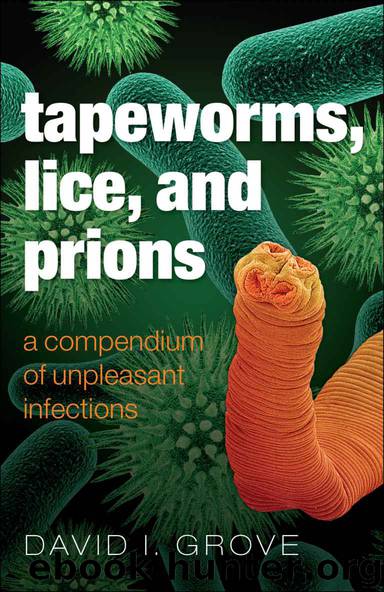Tapeworms, Lice, and Prions: A compendium of unpleasant infections by David Grove

Author:David Grove [Grove, David]
Language: eng
Format: epub
Publisher: Oxford University Press
Published: 2013-12-19T05:00:00+00:00
Figure 149. Cough plate of Bordet–Gengou medium. The arrow points to a clump of colonies of B. pertussis. The other larger colonies are mouth organisms.
Bordet and Gengou had achieved the second of Koch’s postulates. A number of investigators set about proving the third by transmitting infection. Monkeys, dogs, rabbits, guinea pigs, mice, and even chimpanzees were inoculated by swabbing the pharynx or the nasal passages. Once more, utter confusion and chaos followed with contradictory results. The problem was that although all the researchers thought they were using the Bordet–Gengou bacillus, this was not always the case. Some were using a very similar small Gram-negative bacillus, then called the influenza bacillus (now called Haemophilus influenzae), which was often found in large numbers in humans in upper respiratory tract infections. It would take some time before the two could be reliably differentiated. Eventually it was realized that the Bordet–Gengou bacillus grew well on Bordet–Gengou medium after three to four days, forming smooth, glistening pearl-white colonies (Figure 149). On the other hand, the influenza bacillus grew after 24 hours on a medium called chocolate agar (made by heating red blood cells to break them down before mixing them with agar) forming dull, irregular colonies. As time progressed, various immunological and biochemical tests were developed which helped separate the two types of bacteria. The other problem was that some researchers were unknowingly transferring a bacterium now called Bordetella bronchiseptica among animals. This organism rarely infects humans but is a natural pathogen of some animals; it causes snuffles in rabbits and distemper in dogs. On top of all this was uncertainty as to whether the Bordet–Gengou bacillus was actually pathogenic for any of these species of animals or only caused disease in humans.
The pattern became clearer from about 1930 onwards. We can be reasonably sure that researchers were really using the Bordet–Gengou bacillus, which had been renamed Haemophilus pertussis in 1923 by Bergey (p.217) and his colleagues. In 1929 in America, Louis Sauer (1885–1930) and Leonora Hambrecht produced an illness like whooping cough in monkeys, with paroxysmal cough appearing one to three weeks after inoculation. In 1932, Arnold Rich (1893–1968) and his colleagues in the USA generated typical whooping cough in monkeys 24–30 days after inoculation of either pure cultures of H. pertussis or unfiltered mucus obtained from the trachea of children with whooping cough. The pathogenicity of this bacterium was validated when they used mucus which had been passed through a filter to remove bacteria so that they could determine whether a virus caused whooping cough; all the investigators transmitted was a cold which appeared after two to three days. Others then confirmed their findings. Then in 1934 in Japanese-occupied Manchuria, Itsuyoshi Inaba and Seiichi Inamori succeeded in transmitting the disease to puppies. It was looking pretty convincing that H. pertussis was the cause of whooping cough. The third of Koch’s postulates seemed to have been met.
But what about humans? No-one would dare to attempt to give this potentially fatal disease to humans? No-one would give it to their own children.
Download
This site does not store any files on its server. We only index and link to content provided by other sites. Please contact the content providers to delete copyright contents if any and email us, we'll remove relevant links or contents immediately.
| Cell Biology | Developmental Biology |
| Entomology | Marine Biology |
| Microbiology | Molecular Biology |
| Biostatistics |
Sapiens: A Brief History of Humankind by Yuval Noah Harari(13128)
The Tidewater Tales by John Barth(12047)
Do No Harm Stories of Life, Death and Brain Surgery by Henry Marsh(6351)
Mastermind: How to Think Like Sherlock Holmes by Maria Konnikova(6278)
The Thirst by Nesbo Jo(5821)
Why We Sleep: Unlocking the Power of Sleep and Dreams by Matthew Walker(5681)
Sapiens by Yuval Noah Harari(4581)
Life 3.0: Being Human in the Age of Artificial Intelligence by Tegmark Max(4544)
The Longevity Diet by Valter Longo(4468)
The Rules Do Not Apply by Ariel Levy(3939)
The Body: A Guide for Occupants by Bill Bryson(3863)
The Immortal Life of Henrietta Lacks by Rebecca Skloot(3844)
Why We Sleep by Matthew Walker(3799)
Animal Frequency by Melissa Alvarez(3772)
Yoga Anatomy by Kaminoff Leslie(3726)
Barron's AP Biology by Goldberg M.S. Deborah T(3646)
The Hacking of the American Mind by Robert H. Lustig(3602)
All Creatures Great and Small by James Herriot(3543)
Yoga Anatomy by Leslie Kaminoff & Amy Matthews(3421)
